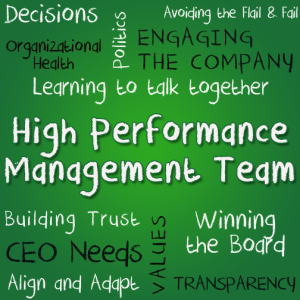 The topic of transformation is a challenging one for all management teams. It’s not surprising that few muster the collective courage necessary to transform their organizations even in the face of sustained headwinds or looming crisis.
The topic of transformation is a challenging one for all management teams. It’s not surprising that few muster the collective courage necessary to transform their organizations even in the face of sustained headwinds or looming crisis.
Certainly, there are different drivers behind the need for significant change. One very common and challenging situation arises when a firm comes face to face with its own impending irrelevance, often created by competitive disruption or technological obsolescence. Another scenario…the one I see most often in technology firms is the need to transform to support growth. Both offer their own unique challenges.
The first situation…impending obsolescence and a high probability of organizational death demands transformation on a major scale. The issues are fairly clear, and the adversary easily observed and studied. While some of the big decisions are obvious…shedding unprofitable endeavors, cutting costs etc. selecting the response or strategy that will postpone or eliminate impending doom is quite challenging. The art and science in this situation isn’t the financial management it’s the strategy and execution work.
In the second scenario, transforming to support scaling…to go from good to great or great to greater, the biggest adversary management teams face is overcoming the comfort of “incrementalism” and wrapping their brains and arms around the need to unite on and drive significant change. The overwhelming emotion for managers is to incrementally fix and tweak and tune what has been working versus taking action to reinvent. What’s needed are new functions, processes, systems and talent with a charter to go to new arenas, and what happens looks more like the duct-tape and flexi-hose repairs I use for sudden plumbing problems. I momentarily stem the crisis, but I don’t fix the systemic issue.
Having lived both of these scenarios in multiple technology businesses, I find the second situation, driving significant change while successful (albeit increasingly stymied by capacity, infrastructure and talent issues) to be the most vexing of the situations. There’s almost never a mandate to change and management teams solve small problems all the while the bigger machine begins to squeak and groan and then smoke. As efficiency and effectiveness decline and good opportunities in new markets or with new products go unrealized, management begins to flail and inevitably, the financials begin to move in the wrong direction.
Navigating and ideally, avoiding the squeaking, groaning and smoking phase takes incredibly strong senior leadership starting at the top with the CEO and carrying through the entire executive management team. In the circumstances where we got this right, the group was able to put ego and personal interest aside and focus collectively on what was right for the business over a longer horizon. The groups found a new performance gear, and while talk of risk and uncertainty dominated much of the dialog (and emotional atmosphere), the unrelenting focus on the need to help the business “Level-Up” defined the mission. There must be unanimity or talk of transformation remains just that.
Conversely, where the need was present but the work failed, these teams lacked the collective courage to consider the topic with anything more than lip-service. Talk of transformation in these cases is infused with politics, self-interest and the dialog if it even turns into that, is more an endless philosophical debate. Those seeking to derail this train are able to easily manipulate the agenda and a less-than-unified team lets it drop. In this case, the focus remains on tackling incremental issues versus systemic. It may work for awhile, but it eventually runs into the brick wall of reality.
The Bottom-Line for Now:
If you and your team have recognized the warning signs of your firm’s structural, capacity, strategic and human limitations, it’s important to begin framing and forming a discussion that looks beyond the symptoms to the underlying issues. The temptation is to attempt to reduce the symptoms with a variety of small fixes. The need is for the team to rethink what it needs to look and act like to ensure a profitable, healthy future. Don’t fight reality. Recognize that the inertial power of the status quo is strong. It takes extraordinary strength to move beyond how we do things today.
—
Subscribe to the Leadership Caffeine Newsletter with subscriber only content. Register here
For more ideas on professional development-one sound bite at a time, check out: Leadership Caffeine-Ideas to Energize Your Professional Development.
New to leading or responsible for first time leaders on your team? Subscribe to Art’s New Leader’s e-News.
An ideal book for anyone starting out in leadership: Practical Lessons in Leadership by Art Petty and Rich Petro.
